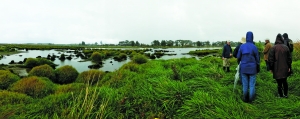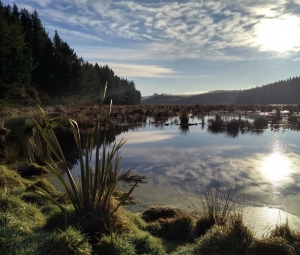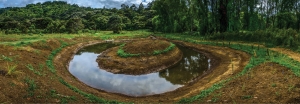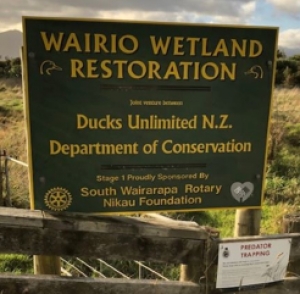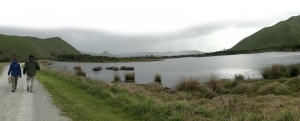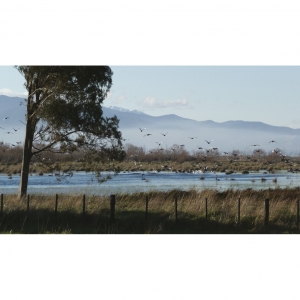Displaying items by tag: Wetland Development
Research scholarships aid restoration
Research scholarships aid restoration of native wetlands
Thanks to Wetland Care Research Scholarships funded by Ducks Unlimited, our student researchers are finding the best ways to recreate a haven for waterfowl.
Wetlands in Aotearoa New Zealand are precious natural resources viewed as taonga by Māori, which provide a habitat for fish and birds.
Even in purely financial terms, wetlands are valuable for their role in filtering nutrients from water, absorbing carbon, and controlling erosion and flooding.
Sadly, they are now in crisis. With over 90% of our wetlands lost over the past 100 years, many plants and animals are struggling for survival, including the elusive matuku (Australasian bittern) and pūweto (spotless crake).
Purple Loosestrife - pretty enemy
Help spot purple enemy at Lake Wairarapa
2022 Wairarapa Moana annual spring matuku and spotless crake survey
First recorded booming within the DU Wairio wetland
The spring 2022 survey report compiled by Shane Cotter, a contractor engaged by GWRC.
John Cheyne of Wetlands Works led annual spring surveys for Australasian bittern (matuku, Botaurus poiciloptilus) and spotless crake (pūweto, Zapornia tabuensis) at selected wetlands within Wairarapa Moana between 2012 and 2021. In 2022, John passed this responsibility to me. I conducted the annual spring (October-November) 2022 survey using the same methodology as in previous years so continued comparisons could be made of the annual results.
This year’s survey focused on the core wetlands (Boggy Pond, Matthew’s Lagoon and Wairio wetland) and the northern wetlands (Barton’s Lagoon, Tauherenikau delta, Simmond’s Lagoon, JK Donald Block). Only booming male matuku are surveyed because females are much less vocal and therefore very difficult to detect and monitor. This booming call is associated with males attempting to attract females for breeding. Pūweto were also surveyed at Boggy Pond and Matthew’s Lagoon.
In the 2022 survey, 11 booming male matuku were located at the core wetlands and 12 in the northern wetlands. This is an increase in previous years and a record number at both locations. At the core wetlands, numbers have remained relatively stable at 8-9 birds since 2014 while at the northern wetlands, annual numbers of male matuku has varied between 3-9 birds. Overall, the combined number of booming male matuku at the core and northern wetlands has steadily increased from 10 in 2016, to 16 in 2018, to 18 in 2020, and now 23 birds in 2022. In addition to the 23 male matuku heard booming during the 2022 survey, three other birds were seen, one in Matthew’s Lagoon near Boggy Pond and two in Wairio wetland.
At Boggy Pond, nine pūweto were located, the most in Boggy Pond since 2018 and significantly up on the single individual in 2021. At Matthew’s Lagoon, none were recorded during the kayak survey which has been a regular result there since 2014. While undertaking the matuku survey, four other pūweto were heard calling independently, not in response to playback calls. Two were calling in Matthew’s Lagoon close to each other while at two locations within Wairio wetland, one individual was heard calling. I believe there are more pūweto present than recorded during the pūweto surveys. They have just moved to different areas of the wetland complex outside the pūweto survey routes seeking more suitable habitat.
On-going predator trapping with the regular servicing of traps is essential as several predators were seen dead in traps within days of the traps being serviced and rebaited with fresh bait by the trapping contractor at the core wetlands. These included a weasel and several rats. All traps observed were well set up and maintained, and had good vegetation clearance.
Follow the 'read more' link to view the survey report.
Wairio on show
About 30 people braved squally rain on Sunday, May 9, for a guided tour of Wairio Wetland led by Ducks Unlimited NZ President Ross Cottle and Director Jim Law.
The event was a Rural Women New Zealand annual event to raise money for the Associated Country Women of the World to help fund community projects in developing countries.
Before setting out, Ross and Jim told the visitors about DU’s long involvement with the wetland – from Stage 1, its initial project about 17 years ago through to the latest development in Stage 4.
Ross said the wetland’s only water source in 2005 was courtesy of high wind dumping water into it from Lake Wairarapa to the west, but it didn’t retain it, and the water flowed straight back into the lake.
DU put in a bund wall, which was moderately successful, holding the water through the bird breeding season, but by December, it had dried out.
The next step was to dig down to a lower level to keep the water there longer, which was more successful, holding the water till the birds had bred and fledged. At the same time, DU planted out native species and these are now well established in Stage 1.
From there, it was on to Stage 2 and 3, and every low spot was fenced off with a bund wall.
Stage 3 was handed over to Victoria University because “we wanted some science behind it”, Ross said. It was envisaged that the project would provide a template for wetland restoration.
“Next thing, someone had a bright idea to put in a bund wall” between the three stages and the lake. About two weeks later, a mighty wind blew water in from the lake and “we had 100 acres of water”. After that success, DU extended the bund all the way back to Stage 1.
This was “amazingly successful” and has created a wetland of more than 250 acres of water.
“We were successful beyond our wildest dreams,” Ross said.
Jim said Wairio had been a ground- breaking project, with the Department of Conservation handing over the wetland’s management to DU – at the time it was unheard of for DOC to hand over restoration of its land to a local group.
“It only took us two years to convince DOC to let us spend our money on their land.”
DU has spent more than $200,000 in the past 17 years. About half of this has come from donations, which began rolling in once people saw how Wairio was being transformed and the return of wildlife.
On the 4.2km walk, Jim led the visitors along the bund wall track through Stage 4 of the wetland, where he described DU’s vision of the future – when stands of kahikatea would replace the current open areas of fescue.
With a rainbow in the background, and Ross bringing up the rear in his side-by-side to assist any stragglers, the tour covered Stages 3 and 2 before reaching its conclusion at Stage 1.
On a small detour from the main track to the water’s edge at Stage 4, the group had a preview of the proposed site for a viewing hide which DU has built. It is now waiting for a resource consent to place it on the site.
Birdlife has flourished at Wairio since DU took over, and the number of royal spoonbills, which previously had not been seen for 30 years, have surpassed 100, and they are breeding there.
Bittern numbers have remained stable in the past four or five years, despite a continuing decline throughout the rest of New Zealand.
Over a hot cuppa back at the cars, the visitors said the tour had been a revelation and they were highly impressed with their tour guides’ continuing passion and enthusiasm for the project.
Takitakitoa impresses trustees
"The best bang for your buck" is how New Zealand Game Bird Habitat
Trust Chair Andy Tannock described Takitakitoa Wetland in Otago on September 19.
Trustees visited the wetland near the Taieri River during the annual meeting of the trust which was held in Dunedin.
It was the first meeting of the new board appointed by the Minister of Conservation in July. It consists of Andy Tannock, DU Board member Neil Candy, former DU president John Cheyne, Jan Riddell, Mark Sutton and Chantal Whitby.
The trust met to review 14 applications made to the trust for wetland projects across the country for 2020 – they subsequently approved 11 of the applications.
The award-winning Takitakitoa project has previously received funding from the trust.
Takitakitoa has been one of the largest wetland enhancement projects undertaken without extra funding help from non-Fish & Game sources. Otago Fish & Game was gifted the lower portion of the wetland in 1994, around 40 hectares, and later obtained the upper portion of the 70ha wetland, through a land swap deal.
The project was launched with a $50,000 grant from the Game Bird Habitat Trust which was largely spent on constructing a 350-metre bund so the valley floor,
which was drained in the 1960s, could be reflooded. This took about two years to complete. Otago Fish & Game Council also put funds into the project.
"It was basically taking 32 hectares of drained, failed farmland and turning it back into wetland," says Otago Fish & Game chief executive Ian Hadland. "Takitakitoa is a shining example of hunter funding being used for greater conservation benefit.
This is an ecological restoration project which has benefits for not just duck hunters, but anyone interested in enhancing or conserving natural habitat for the future."
As soon as water refilled the wetland, all sorts of wildlife turned up, species that had not been previously observed there while it was in its degraded state, he says. "There’s clearly conservation benefits there that even I didn’t expect. Some creatures turned up that I didn’t even know were in the neighbourhood … like the pied stilts. There are probably 30 to 50 that have moved in to live and raise their chicks."
Wildlife included species well outside of Fish & Game’s area of interest such as inanga (whitebait), fernbirds, grey teal and royal spoonbills.
However, Ian points out that mallard ducks and some other game birds have also colonised the area, and allowed for the wetland to be used for novice hunting in particular.
"Getting the next generation of hunters out there to appreciate wetlands and learn their value is important. Those young hunters will undoubtedly fund similar conservation efforts in the future." Takitakitoa is a project that Fish & Game can hold up as "a great example of a duck hunter-funded conservation project", he says.
For more about the wetland and how to apply for Game Bird Habitat Trust funding, go to: youtube.com/watch?v=JtpRBbp6t1w.
In December the Game Bird Habitat Trust was granted $360,000 over three years through the Government's One Billion Trees project.
The money will be used to establish plantings on projects that the trust
supports around New Zealand.
Trust chair Andy Tannock says this is a significant boost for wetland habitat projects and complements the trust’s goals.
Andy says the trust will be working on setting up a process to support the planting of natives such as flaxes and woody species at sites that have received the trust's funding support. Many of the projects are on private land.
Andy acknowledges the work of Dr Matt Kavermann, the senior fish and game
officer for Wellington Fish and Game Council who worked with the Ministry for Primary Industries to establish the grant.
A pond for pateke
Te Henga wetland, which covers 160 hectares and is the biggest in Auckland, has the potential to be the ideal wildlife habitat with acres of reeds, raupō, sedges, open water ponds and the Waitākere River coursing through it.
Forest & Bird’s project Habitat te Henga was born from a desire to protect the
wetland. It started in 2014 with intensive stoat control, using 100 DOC 200 traps, several A24s and some cat traps.
Two trap lines totalling 30 kilometres were regularly checked and reset by a dedicated trapper. Scores of DOC 200s and A24s have been added since.
Effective predator control was required before translocation of pāteke could be considered and the first contingent of 20 pāteke was released in 2015, with a survival rate of 80 per cent, leading to another release of 80 birds in 2016. This has been covered previously in Flight magazine.
This success brought us closer to that ideal habitat and aroused interest and support from the local community and a range of other organisations.
Matuku Reserve Trust Board was established when the last block of bush and wetland came up for sale. The trust was able to buy it in November 2016.
The property, at the head of the Te Henga wetland in West Auckland, has raupō
and sedge beds, and open water ponds along the meanders of the former course of the river.
There are remnant pukatea and kahikatea at the foot of mixed kauri-podocarp-broadleaf forest from which small streams and seeps enter the flats.
With several other conservation projects including the Ark in the Park, Habitat
te Henga, and Forest & Bird’s Matuku Reserve alongside it, the 37-hectare property has been named Matuku Link. Here, a nursery has been established providing most of the plants that are converting the kikuyu-covered flood plain into a range of wetland habitats. An old barn has been transformed and provides not only a volunteer base but already does duty as a site for wetland education to the many school, service, business, and community groups that help with planting and bird releases. An aim is to have an on-site educator to work with schools.
Dozens of local residents have become involved as part of a buffer zone, collecting their traps or bait from the barn and local interest is really heightened when, as has happened in the past two years, pāteke have bred in their ponds or streams.
Also exciting for our neighbouring conservation group to the north was their discovery last year of a pāteke pair that had dispersed several kilometres into the forest-clad stream that disgorges into the te Henga wetland.
New ponds have been constructed at Matuku Link, with one of them sporting a family of seven pāteke ducklings. A more established pair on an existing pond are
so placid and accommodating that almost all visitors get to see them plus or minus their ducklings.
A further new pond was part of a survey for a PhD study on ponds and sampling from its inception over the year showed that it only took five to six months until
the Macroinvertebrate Community Index (MCI) matched that of established ponds. The MCI measures water quality.
Measuring outcomes for wildlife with predator control in place has involved
biennial audio recordings for matuku and pūweto. Pūweto are also surveyed annually. Goodnature A24 traps were deployed 18 months ago between an
existing DOC 200 array to see if a benefit to wildlife could be shown using pūweto as an indicator species.
The DOC 200 traps have been in place for six years and with the recording of fortnightly trap catch data and sightings or detections of matuku [bittern], pūweto [crake] or pāteke, we have a basis to see if change is detectable.
Rodent monitoring is undertaken three times a year by Auckland Zoo staff as part of its Conservation Fund outreach.
Native freshwater fish present include both long finned and short finned tuna, and one stream surveyed also had Cran’s bully, common bully, banded kōkopu and an unidentified galaxiid. These surveys have been done by Whitebait Connection which has also tested water quality parameters. Testing showed high health
of the river and streams.
A second forest-covered stream surveyed showed only eels and kōura but the
presence of a large overhanging culvert is the likely cause of the difference. With Whitebait Connection’s help, a fish ladder has been constructed and followed by
repeat surveying.
At other sites, galaxiids have wasted no time in colonising upstream once
impediments are removed and we also trapped a banded kōkopu upstream of
the culvert within a fortnight.
As well as continuing to use G-minnow traps, we will be taking water samples
to test for eDNA (environmental DNA). Multi-species testing of DNA in the
water will show what fish we have but it is also possible our streams have Hochstetter’s frog and Latia, the native limpet [the world’s only mollusc with bioluminescence].
The rest of the wetland is privately owned, but access to see wetland
habitats is now possible at Matuku Link. River flats make for easy walking but
accessibility for wheelchairs and buggies is being enhanced with good surfaces
and our first boardwalk has its official opening at our World Wetlands Day event in February 2021.
Building this boardwalk and other infrastructure was made possible by the post-Covid Jobs for Nature scheme. Our World Wetlands Day event is one of two open days we usually hold each year but now the barn is finally renovated, we
expect to open more frequently.
The annual kayak trip down the river offers visitors an intimate view of a large healthy wetland as well as being a great fundraising event. This year the event
will be on Saturday, April 27.
Our newest pond, made possible by Ducks Unlimited NZ, is slowly filling and once the plantings are established, we look forward to seeing pāteke and other wetland birds using it.
For more information, visit www.matukulink.org.nz and www.facebook.com/matukulink.
Wairio Wetlands Guided walk-through
Sunday 9 May 2021 at 12.30pm
Rural Women NZ Martinborough invite you to join them on a guided walk through
the Wairio Wetlands on the eastern shore of Lake Wairarapa.
4.2 km one-way, round trip 7 km. Return transport provided if required.
Witness the 15 year restoration programme led by Ducks Unlimited NZ.
Good walking track, sensible footwear required but unfortunately not suitable for wheelchairs.
No toilet facilities available. No dogs allowed. Will go ahead rain or shine.
Directions: From Kahutara Road turn on to Parera Road and continue for approximately 2.6 km.
The gathering point will be clearly indicated.
Cost is $5.00 per person, with all funds to support Associated Country Women of the World,
to assist with community projects in developing countries.
Contact: Marilyn Law 027 2239354 or Viv Malneek 027 5358805 if further information required.

DU's trip to a 'magic place'
The wetland at Nick's Head Station at Muriwai, south of Gisborne, is a world-leading example of positive human interactions with the land, and of what vision and money can achieve.
General manager Kim Dodgshun has worked at Nick's Head Station since 1994, eight years before the current owners bought the property. "They inherited me and we've worked well as a team ever since," Kim says.
When Kim arrived, the land that is now the main wetland was being grazed with livestock roaming all over, and with cows wandering along the beach. "It was nothing like it is today."
Early on, Kim had the idea of creating a bird reserve on the property and ran it past wildlife ecologist and former Wildlife Service ranger Sandy Bull.
The plan, however, hit a snag when the owners at the time said they did not wish to proceed with something that would not produce financial returns.
Undeterred, in 1995 Kim managed to obtain a $15,000 Natural Heritage Fund grant from the local district council and, with Sandy's help, starting trapping. "We caught a big polecat down on the beach," Kim says.
They also put up "No shooting" signs – it had been a popular duck shooting site, fenced off 15 hectares and planted flax around the outside. The birds flocked in, bringing seeds from other wetlands in the area and the plants began to grow.
The story of the wetland took another turn in 2003 when the farm changed hands after the Overseas Investment Commission approved an application from a US billionaire to buy the land, in what turned out to be a 12-month-long process.
He had first visited the farm in 2002 and embraced Kim's plans to create a wildlife reserve.
The final step for the sale was to gain iwi approval. Kim says communication was the key and once the iwi knew what the owner planned to do with the property, the deal was approved.
In response to Kim's plans, the owner said, "Let's make this bigger and better", and brought out renowned landscape architect Thomas Woltz from the US to design the wetland, with advice from Kim and Sandy.
A previous manager who had farmed there for 35 years had set in place the foundations to drain the saltwater from the low lying areas. He put up a netting fence on the beach which collected all the driftwood and storm debris, building a natural wall with sand.
Next, he added another fence on top of that and planted it out with marran grass and other plants.
Later, in the 1960s, a drain was put in to get rid of the remaining saltwater but a narrow, shallow channel remained, with 700 acres of catchment running into it. In summer it dried up. The surrounding paddocks were all very wet with no drainage.
Kim had already planted some native blocks but as Thomas Woltz learnt more about New Zealand and its trees, "the master plan was to revert the land back to how it was 700 or 800 years ago, with a profitable farming operation, back when there were no predators and the land was covered in native trees", Kim says.
Planting began in earnest in 2003 and now there's almost 700,000 natives on the property – coastal varieties with "the big fellas" – rimu, matai and totara – planted among them.
The wetland project began in 2005 – plans were drawn up, the land was surveyed and work began, initially with six diggers.
Kim had warned the contractors that trucks with wheels and 20-tonne diggers wouldn't work in the boggy terrain, but they brought them in anyway and all of them got stuck.
Which left the six smaller diggers. Firstly, a wall was put in to stop the saltwater coming in over the original wall at the beach. "We put in some more small ponds up the valley and worked our way west."
Deep channels – "about 2½-cars deep" – were dug out to ensure the wetland had water year-round.
The material excavated from the channels was made up of a layer of Plasticine-like blue tacky soil sandwiched between shells and "rubbishy" soil. The blue material was used to seal the walls or build the islands, while the "rubbishy" soil helped shape them.
Diggers scraped up the topsoil which was carted on to the shaped islands by trucks with tracks to prepare them for planting.
However, when they came to seal the western side of the wetland, they ran out of the blue soil so plastic liner had to be used in some sections.
"We pegged out all the walls and had three diggers in a row, one digging the holes, another with a big roll of the plastic, working at snail pace, unrolling it, with a third quickly filling it in before the walls collapsed," Kim says. Thankfully, it worked.
"Once it was all done, we had to pump all the water out. "We got council permission to pump it out into the sea over sheets of corrugated iron to protect the beach."
In the process, they found some old kahikatea, big, old stumps of trees, leading them to believe that, pre-settlement, it must have been an old kahikatea swamp.
"There are some stumps on the beach visible at low tide that have been dated at more than 8000 years old," Kim says.
As well as dealing with the challenges presented by the terrain, during planting, they encountered another problem.
Holes were dug with an augur, and some crystal rain put in with soil over the top before the tree was planted with a fertiliser capsule.
Later they went back to one of the islands to put in stakes to mark where the native plants were but found that most of them had been pulled out.
"All the rats were just pulling them out and eating the fertiliser caps. They were having a ball."
The answer was to use about 100 bait stations with Pestoff rat bait, from Farmlands, and "there were bucketloads of rats coming in," Kim says. It's slowed down now.
"That was just another little challenge. I can't believe how well the plants have grown."
Now the islands are all finished and planted with native trees – 10,000 trees to the hectare. On the hills, it's 2500 to the hectare.
The wetland has two 1ha islands and several smaller ones. All the islands are in place of valleys, which was Thomas Woltz's plan, imagining erosion coming down and islands forming.
At its peak, 25 people were working on the project. The labour was all local and all the trees were sourced from the Muriwai area. "Now the locals come to get our native trees," Kim says.
The farm is 3300 acres in total with nine kilometres of coastline. It runs Angus cattle, 285 breeding cows and 3300 sheep. This is likely to be reduced to 3200, with the aim of getting more out of fewer stock, by doing things better, "by selling them when they are ready to go and when the market is ready to take them".
"We are looking at the possibility of going down the regenerative farming path, though the steep contours of Nick's Head Station add to the challenge – more investigations in this area are required."
Facial eczema is a problem so the farm focuses on sourcing facial eczema-resistant stock. The farm uses dicalcic phosphate fertiliser, not straight superphosphate, and nitrogen, which was seldom used, has not been used for about eight years.
The station employs a staff of 16, who look after conservation, including a former DOC worker who does trapping and twice-weekly night shoots by bike, general hands, stockmen, groundsmen, a secretary, a citrus manager and assistant, who have 50 hectares of citrus to tend, plus contractors.
Kim pauses, distracted by something that needs fixing. "Everything we do on this place, we got to maintain it.
"We've got this magic place that we've all had something to do with and created what it is today. We can't let it go back. We can't let wild pine trees start growing.
"We've got convolvulus – we've got to keep taking it out – we've got kikuyu grass on the farm that we have been spraying, we have got to keep at it. "
"The old place never sleeps."
- The bus trip to Nick's Head Station was organised by Kees and Kay Weytmans, who provided delicious, nutritious packed lunches. Kees' efforts to make sure everyone was comfortable during the talks on the jetty by providing lucerne bales to sit on were also much appreciated.
- For more on Nick's Head Station, watch Thomas Woltz's Ted Talk at www.youtube.com/
watch?v=9VlY-3V63yI.
Partnership to help Waituna Lagoon
The improvement of Southland’s Waituna Lagoon and catchment health and wellbeing has become the focus for a number of organisation with statutory roles for this unique site.
The Waituna Lagoon is part of the 20,000ha Awarua Wetland, a designated Ramsar Wetland of International Importance and one of the best remaining examples of a natural coastal lagoon in New Zealand. It is culturally significant to the local Ngāi Tahu people, acknowledged under the Ngāi Tahu claims Settlement Act 1998.
In recognition of the importance of this natural resource, the Department of Conservation (DOC), Environment Southland (ES), the Southland District Council (SDC), Te Rūnanga o Ngāi Tahu and Te Rūnanga o Awarua have formally come together to work alongside the community and other stakeholders for the long-term benefit of Waituna Lagoon, its catchment and community.
Concern was raised in February 2011 about the poor health of the lagoon. Monitoring information from ES and DOC, drawn together for the Report on the State of Southland’s Freshwater Environment, showed it was at risk of flipping into an algae- dominated state.
A multi-pronged emergency response was initiated and remedial practices were put in place, further scientific investigations were undertaken and communication channels established for sharing information.
While flipping remains a potential risk, the focus is now a long-term one to improve the health and wellbeing of the Lagoon, its catchment and community. Formalising the statutory partners’ group is a strong, futurefocused commitment ensuring their actions are aligned and complementary, and that they are working together in the most effective way possible.
Setting and achieving goals will require considerable effort over a number of years. An organised structure to guide efforts allows for a comprehensive and coordinated approach designed to achieve greater improvements than if organisations worked separately and avoids duplication of effort. Working in partnership with the local farmers, the community and industry will be crucial to the success of the project.To recognise the establishment of this formal arrangement, a ceremony took place on August 8 at Te Rau Aroha Marae in Bluff, where the terms of reference to guide the on-going relationship between the partners of the Waituna Partners Group were officially signed.
A web camera recently installed at Waituna Lagoon is providing scientists with regularly updated images of Walker’s Bay, where the lagoon was opened to the sea in late July. Aquatic Ecologist, Dr Andy Hicks said the main benefit of the web camera was to help monitor the lagoon’s opening and closing processes, and to help with the long-term monitoring of environmental conditions in the lagoon.
“The camera allows us to keep an eye on the lagoon without having to physically be there,” he said. Setting up the remotely activated camera was a challenge, plus occasional issues mostly related to the weather. Environment Southland technical staff have now resolved them.
Dr Hicks said the images taken by the camera would be useful for a variety of additional purposes. Recreational boaters would be able to check if lake conditions are suitable for boating, and if the images prove clear enough, the web camera could even be used for monitoring local bird populations.
Wairio - Enthusiasm moves project along
“We had a great day – about 1600 plants in the ground!” was the enthusiastic report from Jim Law after a successful planting day at Wairio Wetland in southern Wairarapa.
Mainly flaxes and sedges (about 1200) were planted around the southern and south eastern sides of the new dam wall at Stage 4 and 400 Totora and cabbage trees planted went in at Stage 2.
A good turn-out included Martinborough School students and staff, Taratahi trainees, Rangitane members, Rotary members, Greater Wellington Regional Council (who provided the sausage sizzle), some Rabobank staff, DOC staff and a few locals plus some co-opted farm workers - about 60 folks in all.
More clover seed was sown on the dam wall at Stage 4 by Ross Cottle and Jim Campbell.
A good year so far at the Wairio Wetland – in total just over 4000 shrubs, flaxes and trees in the ground and a great new dam wall trapping about 30 hectares of water in Stage 4. There is more to come with plans advancing for the reticulation of water from Mathews Lagoon and Boggy Pond into the Wairio Wetland.


